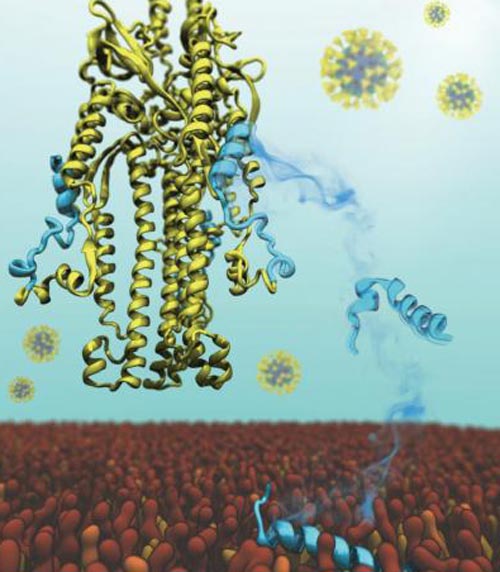New details of SARS-CoV-2 interactions with human cells

The SARS-CoV-2 virus inserts itself into the membrane of a host human cell using a small part of its spike protein (yellow), called a fusion peptide. Computer simulations revealed the parts of peptide that are the most important for sticking to and inserting into the cell membrane. This illustration shows the fusion peptide (in blue) as it approaches, sticks to, and inserts into the membrane (brown, orange and gold).
Image courtesy of Defne Gorgun
In order to infect cells, SARS-CoV-2, the virus that causes COVID-19, needs to insert itself into the membrane of human cells; new molecular models show what parts of SARS-CoV-2 are critical for that interaction, revealing new potential drug targets.
If the coronavirus were a cargo ship, it would need to deliver its contents to a dock in order to infect the host island. The first step of infection would be anchoring by the dock, and step two would be tethering to the dock to bring the ship close enough that it could set up a gangplank and unload. Most treatments and vaccines have focused on blocking the ability of the ship to anchor, but the next step is another potential target.
New research by Defne Gorgun, a graduate student, and colleagues in the lab of Emad Tajkhorshid at the University of Illinois addresses the molecular details of this second step, which could inform the design of drugs that block it. Gorgun will present her research on Thursday, February 25 at the 65th Annual Meeting of the Biophysical Society to be held virtually.
In order to infect our cells, the virus that causes COVID-19, SARS-CoV-2, first attaches a molecule on our cell surface, but then it has to fuse with human cells. Before the pandemic, Gorgun was studying the interactions of molecules that stick to and insert into cell membranes, and when COVID-19 began to spread, Gorgun quickly pivoted her studies to understand how SARS-CoV-2 fused with cells.
A small region of the SARS-CoV-2 outer spike protein called the “fusion peptide,” inserts itself into the human cell membrane to begin the fusion process. Scientists knew the location and approximate shape of the fusion peptide; however, they did not know exactly how it interacted with and penetrated into the human cell membrane and whether there would be changes in its shape when it stuck to the membrane. Without knowing the three-dimensional interactions between the SARS-CoV-2 fusion peptide and the cell membrane, it is not possible to design drugs that specifically disrupt that interaction.
Using computer simulations, the team merged what is known about the SARS-CoV-2 fusion peptide with the established three-dimensional structures and behaviors of other coronavirus fusion peptides and simulated its interaction with a model human cell membrane. Their simulations reveal how the SARS-CoV-2 fusion peptide interacts with, and penetrates, the cell membrane. “Our study shows which parts of the fusion peptide are important and how it sticks to and sits in the membrane,” Gorgun says.
Because their model is theoretical, the next step is to repeat their computer experiments in the lab with pieces of SARS-CoV-2 and cell membranes. But having already revealed parts of the fusion peptide that are likely to be critical to its function, those experiments will likely be completed faster and more efficiently. After that, Gorgun says, it will be possible to start testing drugs that disrupt the interaction and could help block SARS-CoV-2 from docking at our cells.
All latest news from the category: Life Sciences and Chemistry
Articles and reports from the Life Sciences and chemistry area deal with applied and basic research into modern biology, chemistry and human medicine.
Valuable information can be found on a range of life sciences fields including bacteriology, biochemistry, bionics, bioinformatics, biophysics, biotechnology, genetics, geobotany, human biology, marine biology, microbiology, molecular biology, cellular biology, zoology, bioinorganic chemistry, microchemistry and environmental chemistry.
Newest articles

Superradiant atoms could push the boundaries of how precisely time can be measured
Superradiant atoms can help us measure time more precisely than ever. In a new study, researchers from the University of Copenhagen present a new method for measuring the time interval,…

Ion thermoelectric conversion devices for near room temperature
The electrode sheet of the thermoelectric device consists of ionic hydrogel, which is sandwiched between the electrodes to form, and the Prussian blue on the electrode undergoes a redox reaction…

Zap Energy achieves 37-million-degree temperatures in a compact device
New publication reports record electron temperatures for a small-scale, sheared-flow-stabilized Z-pinch fusion device. In the nine decades since humans first produced fusion reactions, only a few fusion technologies have demonstrated…





















